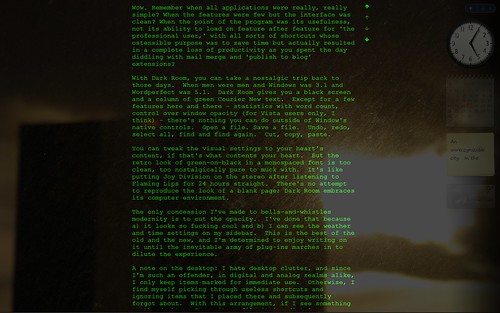With Dark Room, you can take a nostalgic trip back to those days. When men were men and Windows was 3.1 and Wordperfect was 5.1. Dark Room gives you a black screen and a column of green Courier New text. Except for a few features here and there - statistics with word count, control over window opacity (that may be a Vista-only feature, but don't quote me) - there's nothing you can do outside of Window's native controls. Open a file. Save a file. Undo, redo, select all, find and find again. Cut, copy, paste.
You can tweak the visual settings to your heart's content, if that's what contents your heart. But the retro look of green-on-black in a monospaced font is too clean, too nostalgically pure to muck with. It's like putting Joy Division on the stereo after listening to Flaming Lips for 24 hours straight. Most interesting and gratifying of all, there's no attempt to reproduce the look of a blank page; Dark Room embraces its computer environment.
The only concession I've made to bells-and-whistles modernity is to cut the opacity. I've done that because a) it looks so fucking cool and b) I can see the weather and time settings on my sidebar. This is the best of the old and the new, and I'm determined to enjoy writing on it until the inevitable army of third party plug-ins marches in to dilute the experience.
Here it is in all its nekkid glory:

And here's how I use it:

A note on the desktop: I hate desktop clutter, and since I'm such an offender, in digital and analog realms alike, I only keep items marked for immediate use. Otherwise, I find myself picking through useless shortcuts and ignoring items that I placed there and subsequently forgot about. With this arrangement, if I see something on the desktop, I use it or file it immediately.
My frequently used programs are all located on the Quick Launch menu in the task bar, which you can't see because I hide it. Because I'm just that way.
***
Note: Dark Room requires the Microsoft .NET Framework 2.0 to run. I believe that Vista comes with .NET, but for XP/2000/2003 you may need to download it. I don't know a great deal about the in and outs of .NET, so you may want to do your own research.
For those of you who hate .NET but still like the sound of Dark Room, a guy named Duncan Jauncey (a name that reminds me inescapably of Chauncey Gardener) wrote a Java-based version called JDarkRoom. Coders may have weird libertarian beliefs and Doritos crumbs on their shirts, but god bless them all for doing what the rest of us are completely incapable of doing.
If you're reading this on a Mac and you use OS X 10.4 or later, you can use WriteRoom.
If you try it out and your computer blows up, it's not my fault.
To sum up:
- Dark Room (Windows XP/2000/2003/Vista)
- .NET Framework 2.0 (required for Windows)
- JDarkRoom (Java-based version of Dark Room)
- WriteRoom (for Mac)
- Not my fault if your computer catches fire.
If your computer were to catch fire, it would probably look like this. You would not be so lucky to have some guy giving you helpful instructions like "If this were a real life situation, the best strategy would be to move away from the laptop, quickly". Worth watching for the strange contrast between the narrator, who sounds a bit like a golf commentator, and the guys off-camera who say "Yeah!" every time another battery cell explodes.
*
UPDATE: Sgazetti from the well-worth-your-time Isoglossia points out that I neglect to mention the main selling point of Dark Room: in full screen mode, it provides a completely distraction-free writing environment - no notifications, no other windows, just you and the text. He goes so far as to call it "interesting" that I not only fail to point this out, but that my modifications for use have more or less defeated this purpose. I think he means "interesting" in the way that a startled grasshopper's habit of repeated leaps into a wall is interesting.
5 comments:
while my lack of posts and actual physical existence of writing might prove otherwise, i use writeroom. i like it - it's simple and does one thing, which is all i need it to do
I just started using Scrivener, but if it doesn't work out between us I'm totally switching to Write Room.
Scrivener looks really cool. Now I wish I had a Mac.
Mathew sums up Writeroom/Dark Room really well - simple, does one thing. There's something kind of refreshing about it. Like a cool glass of Zima.
I like the WriteRoom. I find it interesting, though, that you undersell (and in fact subvert) what is, for me, its main selling point: not the fact that it's simple, but that it overlays all the frickin' distractions, thus forcing you to write, damn it. I write one paragraph in Word and then see my feed reader bounce, or Gmail notifier go off, etc, and my concentration is shot. I use WriteRoom to screen all that crap out. Dropping the opacity would defeat its purpose for me.
But then again, I am preternaturally beguiled by shiny things.
Sgazzetti - Oh yeah. I suppose that by reducing opacity, I'm undercutting the main point of the program. But I've configured my desktop with a set of pretty strict filters - the only information seeping through is what I want to see, so there are no extra distractions.
My wife finds my Dark Room setup disturbing and repulsive.
Post a Comment